Warriors: From one-dimensional and one-and-done to NBA title favorites

This is an extended version of an article that appears in the Feb. 23 edition of SI. To subscribe, click here.
The giant in the yellow T-shirt lumbers across the concrete, advancing on his target.
It’s a Wednesday evening in late January, in the cavernous underbelly of Oracle Arena, minutes before the first-place Warriors are to host the Rockets. Golden State’s primary owner, 59-year-old Joe Lacob, has just finished speaking to a bunch of venture capitalists in North Face vests. Straddling a stool in a private room, Lacob spoke of penciling profits and leveraging assets and the general awesomeness of Steph Curry. But now he’s headed toward the tunnel to his courtside seat. Before he can get far, however, the giant intercepts him.
“THANK YOU JOE!” the man bellows.
Lacob peers up and recognizes the looming figure of Bill Walton, whose son Luke is a Warriors assistant coach and who, for reasons that never become totally clear, crashed the VC event and asked a handful of relatively complex financial questions.
“THANK YOU!” Walton shouts a second time, pumping Lacob’s hand. “Thank you for everything you’ve done!”
Lacob smiles, nervous. “It feels weird when people say that,” he says. “We haven’t accomplished anything yet.”
“But you have!” booms Walton, becoming serious. “You’ve changed EVERYTHING. You’ve made people BELIEVE again.”
Belief. When it comes to pro basketball in the Bay Area, it is a recession-proof currency, forever propped up by an enduring fan support that even team COO Rick Welts calls, “unexplainable.” This is a franchise that has taken and taken from its fans while providing little in return.
No one expected change to come this quickly, though. Five years ago, when Lacob and Peter Guber bought the team for $450 million, the Warriors were 25-56 and coming off a stretch of 14 losing seasons in 16 years. The roster was riddled with D-Leaguers. The previous owner, the reclusive Chris Cohan, was loathed by fans. The coach – Don Nelson, in his final, melancholy, hangdog iteration – was already daydreaming about his beachfront home in Maui.
And now? Now, the Warriors are riding a 107-game sellout streak. At points this season they’ve had the top-ranked offense and defense. Their core is young and talented, their coaching staff deep, their owner committed and their executives earned the “Sports Team of the Year” award from Sports Business Journal for 2014.
Which leads to the question that all the North Facers want answered: How, in just five years, and without a draft pick higher than No. 6, did the Warriors go from a joke of a franchise to one of the best in all of sports?
The answer is about basketball and business, of course, but ultimately it’s about people. It involves a prideful preacher and a mad scientist, a spindly point guard and a passionate power forward, an impatient multimillionaire and a UCLA walk-on. And, in perhaps the most crucial role in the months to come, a professor’s son with a knack for diplomacy.
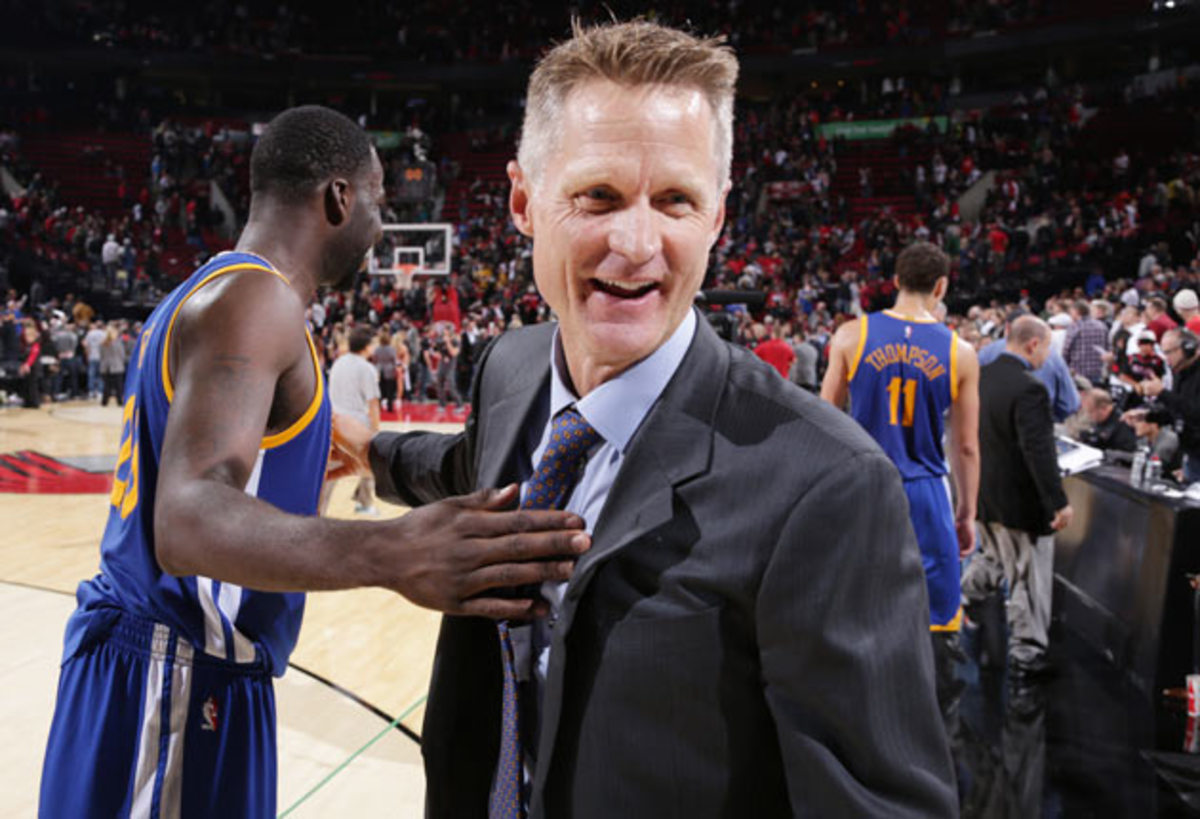
At 49, Steve Kerr still looks more like a YMCA All-Star than an NBA player, all bones and elbows and spiky blonde hair. During his years with the Bulls and Spurs, Kerr was the guy who, sizing him up, you figured you might be able to take on a good day. Skinny, short, bereft of hops. And yet, somehow, magically, he won five titles, earned the trust of Michael Jordan and retired as the game’s all-time leading three-point shooter.
Now, as a coach, Kerr can give off a similar vibe: The Guy Who Just Got Lucky. He merely inherited a great team, Kerr tells you. It’s all about the players, he stresses. Don’t talk to me, talk to my assistants -- they’re the ones doing the real work. This story? Kerr doesn’t want it to be about him. Really, he says, there are more important things to write about.
Sorry, Steve. Not going to happen. Because there’s one major difference between last year’s Warriors, which finished 51-31 before losing to the Clippers in the first round of the playoffs, and this year’s team, which returned its top seven rotation players and entered the All-Star break with the best record in the NBA at 42-9. And that difference looks a lot like a spiky-haired YMCA All-Star.
Kerr always planned on coaching, but it wasn’t until two years ago, while working as a broadcaster for TNT, that he says he began preparing in earnest. That summer he attended a sports leadership conference at the Aspen Institute in Colorado and ran into Jeff Van Gundy, whose work Kerr admired. Van Gundy told Kerr what he tells all aspiring coaches: Write down everything. Everything you’ve learned, everything you want to do. Everything you’d change. It’ll organize your thoughts. Develop your philosophy.
So Kerr created a Word file on his laptop. Some days he added a few notes; other days he filled pages. During four years of college and 15 seasons in the NBA, Kerr played for Lute Olson, Lenny Wilkens, Phil Jackson and Gregg Popovich. His teammates included Mark Price, Tim Duncan, Scottie Pippen and Jordan. There was a lot to write, and no detail was too small. He jotted down offensive sets and defensive philosophies, but also included the little stuff - everything from a policy for families traveling on the road to whether players are required to do 20 minutes of cardio after a game if they don't play a certain number of minutes.
Kerr began collecting plays too, pausing games on the flat-screen at his San Diego home whenever he saw an action he liked – a backdoor lob off an inbounds or a particularly potent flare screen. Then he’d shoot an email to Kelly Peters, a friend and coach at nearby Torrey Pines High (and now a Warriors advance scout). Peters pulled the footage and compiled it using iMovie. Week by week, Kerr’s file – named ATOs, for ‘After Timeouts” – grew.
By the spring of 2014, the video library had swelled to over 50 plays and the Word file had morphed into a detailed Power Point presentation. Kerr loved broadcasting, just as he’d enjoyed playing, but friends believed coaching was, in the words of Bruce Fraser, a Warriors assistant who’s been close to Steve since the two played together at Arizona, “his calling.” Now, with two of his three children off at college, it was time.
The plan was simple, and seemingly foolproof: Follow his mentor, Phil Jackson, to New York. But then the Warriors, coming off a second straight playoff appearance, did something unexpected: They fired their coach, Mark Jackson.
San Francisco Chronicle columnist Bruce Jenkins, the dean of Bay Area sportswriters, called the move a “risky gamble,” labeling Lacob as “meddling” and “pathetic.” “I don’t buy this notion that, with a new coach, these same Warriors reach the NBA Finals next year,” wrote Jenkins. “Dead wrong. Zero chance of that.”
James Harden, the NBA's unlikely MVP
Privately, Lacob fumed. Publicly, he conducted a high-powered coaching search. In early May, he offered the job to Kerr who, after consulting with Popovich, as well as family and friends, took it, thereby breaking Phil Jackson’s heart. But the Warriors offered a better roster, proximity to his family and a stronger organizational structure. Still, it was a weird situation to enter. Expectations were simultaneously high and low. You better win at least 51 games. But we don’t think you can do much better.
To find success, Kerr knew he needed people to buy-in. He began with the most important man in the franchise.
[pagebreak]
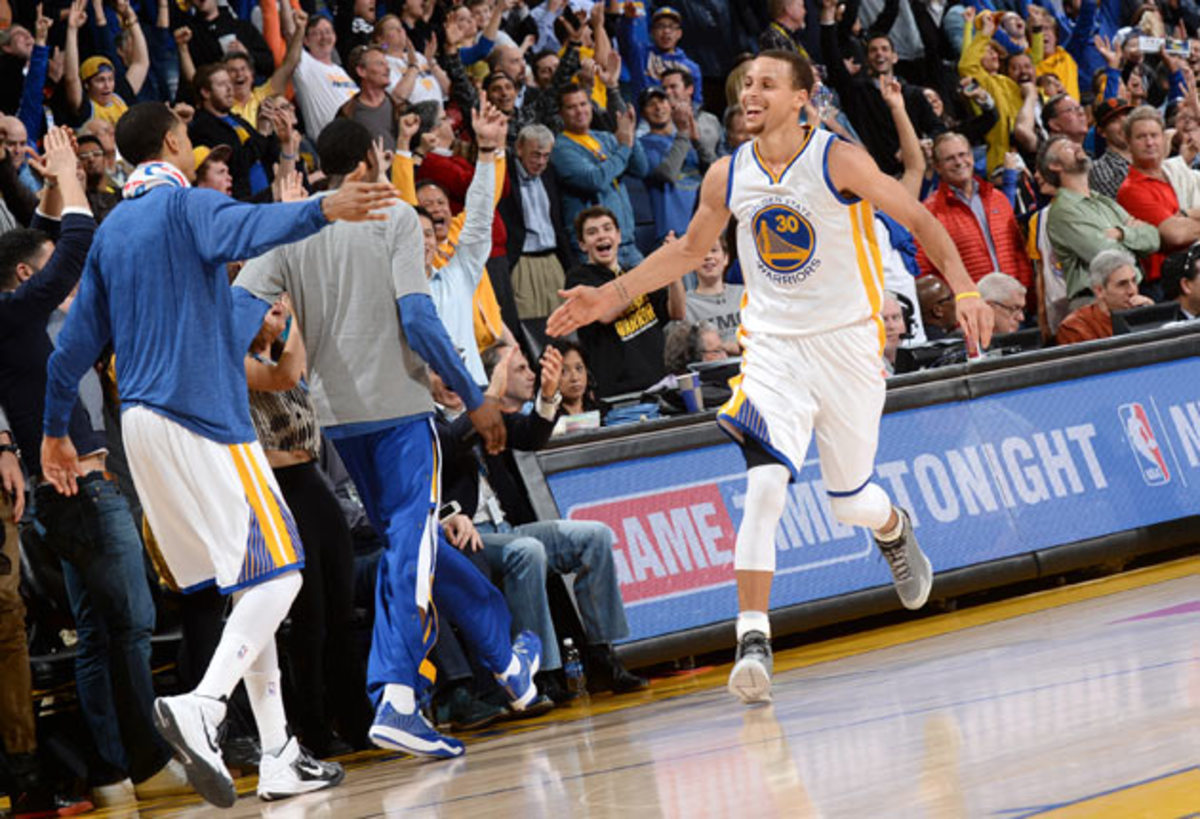
Of the 15 players on the Golden State roster, it is strange to think that the 26-year-old Steph Curry is now the longest-tenured. Especially because he never should have been a Warrior.
The year was 2009 and Don Nelson couldn’t believe it. The Minnesota Timberwolves had just taken two point guards in the first six picks and neither was named Curry. Nelson had long been enamored of Curry, seeing in the skinny Davidson star the playmaking and shooting skills of Steve Nash. Nelson and then-GM Larry Riley had Curry ranked second overall in the draft, behind only Blake Griffin. “And there wasn’t really anyone else we liked,” says Nelson. When the Timberwolves took Ricky Rubio and Jonny Flynn, shouts of joy echoed in the Warriors draft room in Oakland. Curry was theirs.
It would be the last significant contribution Nelson made to the Warriors. He was fired soon after Lacob took over, but Curry remained. Beset by ankle injuries and mismanaged by interim coach Keith Smart, who often pulled the young guard after bad turnovers and in favor of veterans, Curry flourished under Mark Jackson, whom Lacob hired in June of 2011 to replace Smart.
As a point guard for 18 years in the league, Jackson had catered to stars, setting up players like Patrick Ewing and Reggie Miller. Now, as a coach, he did the same. He encouraged Curry to run endless pick-and-rolls and go one-on-one. The rest of the team? Much of the time their job was to set screens for Steph. Or feed Steph. Or guard the opposing point guard while Jackson hid Curry on a weaker offensive player. The strategy worked in at least one important respect: Curry got better. He was allowed to make mistakes. His confidence grew. He became an All-Star.
Meanwhile, the Warriors evolved as a team, due in part to Jackson’s influence. He emphasized individual skill development, mandating that every player put in at least 15 minutes of extra work with an assistant coach. A pastor at a non-denominational church in Reseda, Ca, Jackson had an uncanny knack for fostering an us-against-them mentality. To this day, the Warriors still exit each huddle yelling “Just Us!”, a unifying chant that began in the Jackson era. Upon his hiring, Jackson had immediately – and foolishly – promised that the team would make the playoffs in his first season. The Warriors didn’t, and wouldn’t for two more years, but Jackson’s formidable public confidence and oratorical skill – which, says one team source, is what got him the job over then-Spurs-assistant Mike Budenholzer, because, “Of course Mark’s going to win the interview” – buoyed the players’ confidence.
Jackson was the right man at the right time. In many respects, though he was the wrong man for the long run.
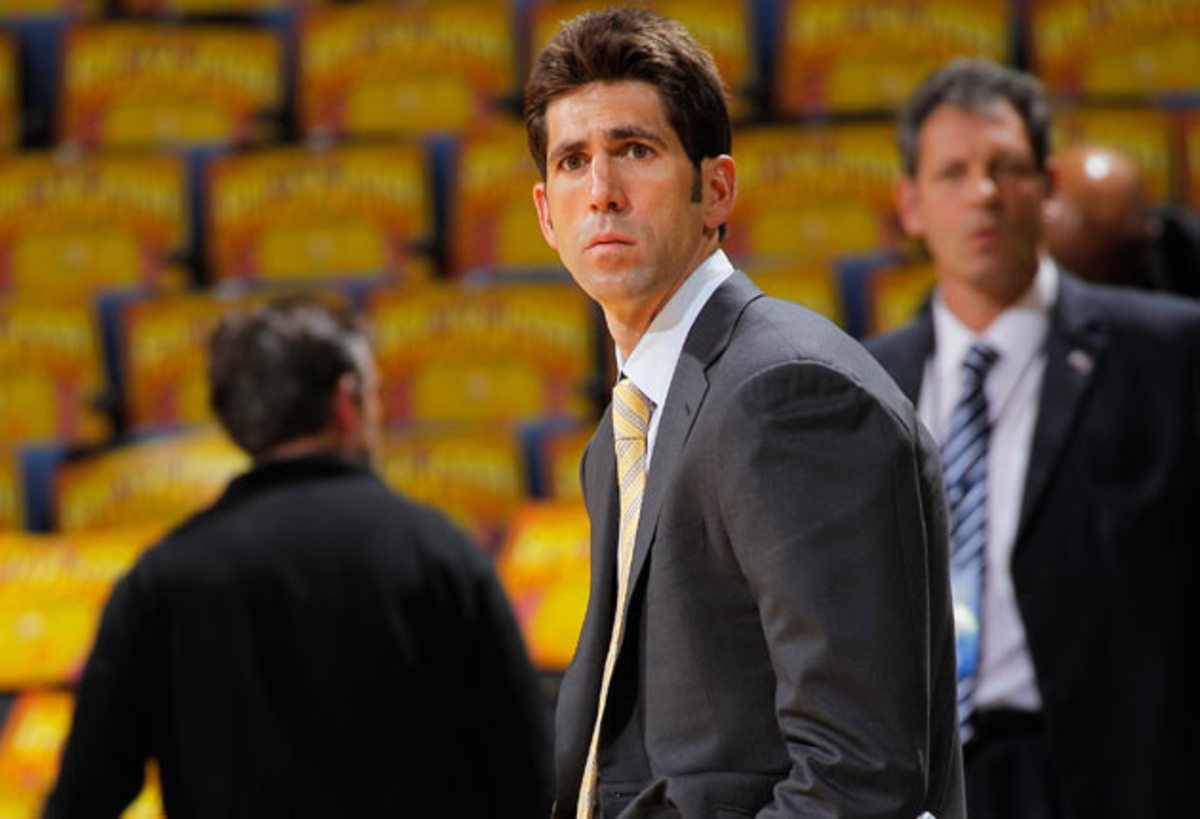
Golden State GM Bob Myers looks younger than his 39 years. Tall and lanky, with a thatch of dark hair and big eyes, he has both the physical presence of a former athlete – he walked on at UCLA and still plays intense full court 1-on-1 games after Warriors practices against advance scout Chris DeMarco – and the social acumen of an agent, which he was for 14 years. Hired in 2011 to apprentice under Riley as an assistant GM, Myers impressed Lacob so much that he was elevated to general manager in only a year.
From the beginning, Myers and Lacob followed a plan. It revolved around a few key tenets. First, that the future of the league lay in position-less players. Size, length and versatility were more important than traditional designations. Second, despite recent trends, they believed that centers still mattered. Third, they believed that organizations flourished when stocked with high-character people. “I’d noticed that sometimes the most talented people don't help the bottom line in regards to winning,” explains Myers. The executive motto became, in Myers’ words, “Size, then character.” They began with a significant advantage, possessing in Curry a tiny Tim Duncan. “Our best player is arguably our highest character player,” says Myers. “It's like having a CEO that exhibits the highest character. Everybody else falls in line.”
Meanwhile, Lacob set about changing the business side. In an effort to create both literal and figurative transparency, he ordered executive office walls to be replaced with glass. He informed basketball operations that, instead of being the team that sold draft picks, they’d now be buyers. And he took aim at the best in the business, luring Jerry West to become head consultant and then recruiting Welts, who dreamt up the concept of All-Star Weekend and the Dream Team during a 20-year stint with the NBA. This would prove to be Lacob’s MO heading forward: Always go for the gold.
In March 2012, the Warriors traded Monta Ellis, the team’s most popular player but a redundant piece next to Curry, to Milwaukee for center Andrew Bogut, an elite defensive big man. They drafted one big, long position-less wing after another – Klay Thompson (6’7”), Harrison Barnes (6’8”), Draymond Green (6’7”) – and hit on a surprising number of them. They filled in holes with free agents like Jarrett Jack and Carl Landry, and acquired Andre Iguodala (6’6”), yet another long-limbed wing, while unloading the bloated salary of Andris Biedrins. In a business where 50% is a good success rate on personnel decisions, it was a remarkable hot streak.
By last spring, Lacob’s five-year plan was ahead of schedule. Golden State had the talent and the mindset. There was just one more move to make.
During Kerr’s three-hour interview last May, at an airport conference room in Oklahoma City, many things impressed Golden State’s decision makers. First was the Power Point presentation, which by then ran 16 pages. It began with a section titled “Why I’m Ready To Be A Head Coach” and included segments on leadership, relationships, analytics and everything from dress code to dieticians to yoga instructors to sleep specialists. Kerr also included detailed thoughts on Warriors players, including potential rotation changes. But what sealed it, at least for Lacob, was Kerr’s list of potential assistants. At the top, along with David Blatt (now the Cavaliers’ coach), were Alvin Gentry and Ron Adams, two of the top strategists in the business. Here, Lacob knew, was a man who wouldn’t feel threatened by those around him.
This, in the end, had been part of Jackson’s undoing. Upon joining Golden State, he’d instituted a rule forbidding assistant coaches from talking to the press. Even so, assistant Mike Malone received credit for the team’s improved defense, which angered Jackson (who declined to comment for this story). Within the team, he pitted players against each other to gain loyalty. “He’d say, ‘You’re my guy, and so-and-so is a clown,’” recalls one person with knowledge of the situation. “Then he’d go say the same thing to the other player, only reversed.” When Jackson became frustrated with Malone’s growing profile, he gave the defense to someone he could trust, Darren Erman. At the time, Erman, a former lawyer, was a recently-promoted assistant with no experience running an NBA defense. Fortunately for Jackson, Erman thrived in the role, molding a top-tier defense.
Then, last spring, things got downright strange. In March, without explanation, Jackson reassigned Brian Scalabrine, a well-liked assistant, to Golden State’s D‑League affiliate; in April, Erman was fired for violating team policy. (Jackson later cited “disrespect” in Scalabrine’s firing; Erman was reported to have secretly recorded team meetings.) Players became wary of publicly crediting assistants, lest they incur Jackson’s wrath. Meanwhile, the Warriors were heading into the postseason with a depleted, relatively inexperienced coaching staff and a number of troubling losses. To the Knicks, Hornets and Timberwolves at home. To the Spurs at home even though San Antonio sat its starters.
While Jackson excelled as a leader, he was not interested in the minutiae of coaching, according to sources. He so rarely watched film that the video team eventually stopped loading clips onto his laptop. He didn’t draw up plays during huddles, or carry a clipboard. He often looked at his cellphone during practice, even when management was around. His relationship with the front office grew more strained.
There were other, cultural concerns. Jackson often emphasized his faith with the players. “It’s fine to be religious,” says one Warriors insider, “but it’s a different thing to bring it to your work.” When Jason Collins publicly announced his homosexuality in April 2013, Jackson told reporters, “I know Jason Collins; I know his family and am certainly praying for them.” This seemed particularly tone-deaf considering that Golden State COO Rick Welts, the first high-ranking sports executive to come out, worked in the same building. Welts says he approached Jackson and had “a nice conversation, like grown‑ups,” adding, “He knew how I felt, I knew how he felt. I’m sure he thought it was an opportunity to educate me, and I thought it was an opportunity to educate him.”
By the time the season ended, Lacob felt the situation had become too dysfunctional. Jackson no longer fit with his larger vision for an integrated, inclusive operation. As he later told a venture capital luncheon, by way of explanation: “You can't have 200 people in the organization not like you.” (Afterward, Lacob felt bad about the comment. “I didn’t know it was being taped,” says Lacob of the event. “But that’s no excuse.”)
With Kerr’s hiring, Lacob hoped to restore stability. One of the new coach’s first moves involved a reclamation project.
[pagebreak]

Harrison Barnes was shocked when Kerr called him last May and said he wanted to meet him wherever he was. “That’s big, actually making the commitment to fly out and see guys,” says Barnes, who was in Miami at the time. “It would’ve been easy for him to fly and meet Steph and just call everybody else.”
A talented 22-year-old forward, Barnes was coming off a miserable season. As the leader of the second unit, he was expected to score, and often out of isolation sets. It hadn’t worked. “The best players in the league shoot only 20%, 30% or so on iso plays,” Kerr said when they met, at the Four Seasons in Miami. “Any idea how well you shot?”
Barnes grimaced. “Probably way lower than that?” he ventured.
Kerr nodded. “I don’t think you were used last year in a way that was best for you. But if you buy into what we’re saying, you have a chance to be successful.”
Over the weeks that followed, Kerr met with a number of other players, including flying to Australia to see Bogut. He gave them all the same message. Here is what I’m hoping to do, here’s why and here’s how. The players, some of whom had been conspicuously silent when Kerr got hired, appreciated the no-BS approach. “I think he was destined to be a coach,” says Klay Thompson. “Just the way he’s composed. He’s got a real good way of dealing with people.”
This may have something to do with Kerr’s upbringing, which is well-chronicled. When Steve was 18 and a freshman at Arizona, his father, Malcolm, was working as the president of American University in Beirut. On January 18, 1984 as the elder Kerr headed to work, he was shot twice in the head and killed. Three years later, as a Wildcats senior, Kerr became a central character in John Feinstein’s book, A Season Inside, which paints a portrait of a scarred yet uncommonly mature young man. In 1987, Arizona coach Lute Olson told the New York Times that Kerr was, “the smartest player that I've ever coached or ever seen.” At an age when most young men were still forming their identity, Kerr already knew exactly who he was.
Now, as a coach, he wanted to be both firm and fair. And that meant making tough decisions. The first, and potentially riskiest, involved Barnes. After two weeks of training camp, Kerr knew that Barnes needed to start to fulfill his potential, so he could play off of Curry and Thompson. And that meant telling Andre Iguodala, a former All-Star who’d started the first 758 games of his career, that he was going to the bench.
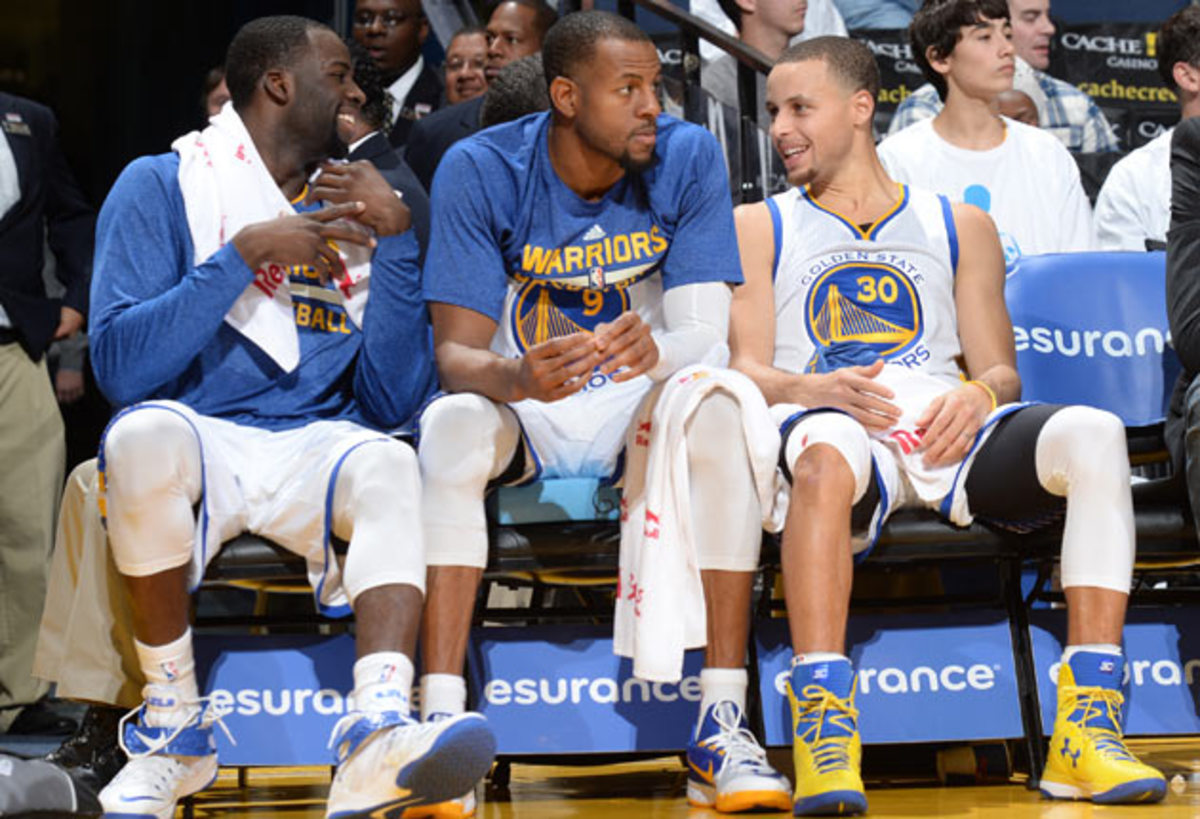
Iguodala was skeptical at first. “But it’s important not to dismiss things immediately so I thought on it,” he says. Kerr had made some good points. The second unit, so ineffective the previous season, needed Igoudala’s leadership and playmaking. And Iguodala appreciated Kerr’s directness. “I agreed with his larger vision,” he says. Plus, he adds, “I’ve been in this league 11 years and I want my professionalism to be something that stands out.” In the end, he accepted the demotion gracefully. “Who else is going to complain now?” says Kerr.
Then, in November, Kerr got lucky. David Lee got hurt, straining his left hamstring. A two-time All-star and a favorite of Lacob and many fans, Lee is a gifted playmaker and finisher. He is also a subpar defender who lacks the range to be a stretch four. Assistant coaches had pleaded with Jackson to move Lee to the bench the previous season in favor of Green, arguing that it would tighten the starting unit’s defense and provide a desperately-needed offensive boost to the bench, but Jackson stood firm.
Kerr claims he intended to do the same. “If David Lee doesn't get hurt, he's still starting for sure,” says Kerr.
But Lee did get hurt. And thus Kerr unleashed upon the league a unique, and uniquely voluble, defensive force.
It’s a Warriors home game in late January and Draymond Green is hearing it.
“He’s too little! TOO LITTLE!”
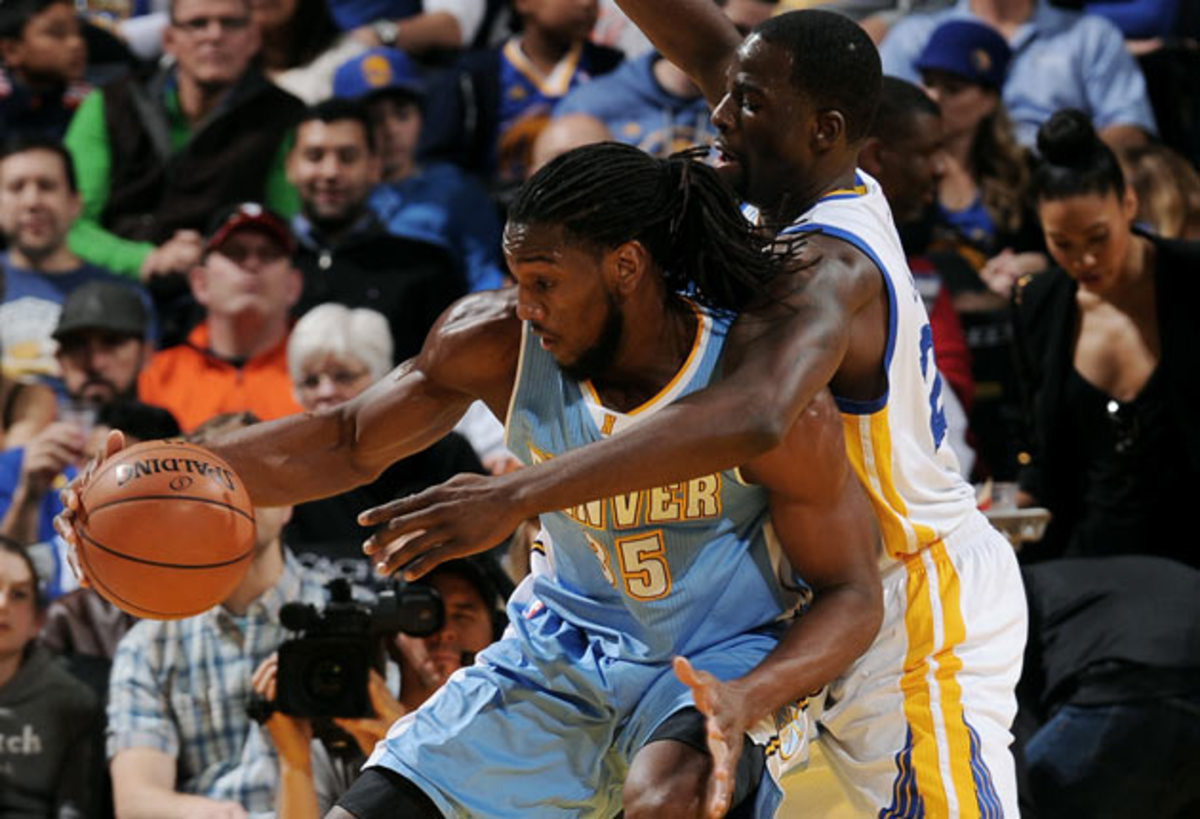
That’s the Denver bench, shouting at Green, who just got ducked in twice – hoops jargon for scoring on deep inside position – by 6’8 Nuggets power forward Kenneth Faried, who is springy and muscular. And now Green, who is 6’6 without shoes, not much of a leaper and won’t be on the cover of Men’s Health anytime soon, is being told that he’s too little. And, as Green says, “That does not sit well with me at all.”
His whole life, Green’s been told that he’s too this or not enough that. An older sister used to sit on him and twist his legs to see if he could break free. One of his brothers, springy and athletic, challenged him to jumping contests in the house, knowing he’d win. The men down at Civitan Rec Center in Saginaw, Michigan mocked the chubby kid. Even after Green won high school state titles and led Michigan State to two Final Fours, the talent people projected him as a “tweener.” Which is code for - you guessed it - too little.
What they overlooked was Green’s versatility and mindset. He is, in the best sense, the perfect pick-up hoops teammate, willing to do whatever’s necessary to help a team win. That’s how he earned respect at Civitan and MSU and, later, in workouts with the Warriors. “His team just kept on winning all the drills,” says Myers. Meanwhile, assistant GM Travis Schlenk remembers something else from that workout: “Draymond kept blocking jumpshots,” says Schlenk. “He must have blocked three on the perimeter. You know how unusual that is?”
Now, Green is the unlikely anchor of the Warriors’ top-ranked defense, one of the few humans who can guard both Dwight Howard and Chris Paul. As of All-Star break, he leads the league in defensive rating and defensive win shares and is being mentioned as a potential Defensive Player of the Year. “The thing I love about him is he hates to be scored on,” says Adams, the team’s Yoda-like assistant coach, “and that’s all you want in a defensive player.”
Under Adams, the Warriors run a “shell” protection scheme predicated on length, anticipation and the ability to think and act decisively. They switch most every pick and roll, taking advantage of all their interchangeable parts, and Adams expects everyone to contribute. To him, there’s no such thing as an innately poor defender. In Chicago, he helped Kyle Korver become part of a top defensive scheme and now he wanted to do the same with Curry. “I don’t think you’re a bad defensive player,” he told Curry last summer, “but you don’t play enough possessions well.” (He also said, “Prove to me you’re better than your dad.”) Steph embraced the challenge. Though he now regularly covers opposing point guards, he’s improved from an average to above-average defender, posting one of the top ten defensive ratings in the league while leading the NBA in steals, which he accrues without gambling in passing lanes.
Still, Green is the heart of the defense, banging and bodying and talking trash (Tim Duncan is the only forward Green says he won’t jaw with, partly out of respect and partly because, “You say something to Timmy, he just look at you with that Timmy face like, ‘Wow, you’re talking to me!’”). And yet, Green disappoints himself daily. “I feel like each possession is a battle and you never want to lose a battle,” Green explains after a recent practice. “And if somebody scores on me, it really bothers me. It doesn’t make me feel any better if it’s Kevin Durant and he hits those shots on everybody. Well, I’m not everybody.” Green leans forward, getting fired up. “People say, ‘That’s great offense, there’s nothing else you can do.’ No, I could have done something else, because he scored.”
Which brings us back to the Nuggets game. On four other occasions already, Faried has tried to post Green and tossed up, in Green’s estimation, “garbage shots.” But that doesn’t matter, because Green can’t stop thinking about the two baskets Faried did make. “The one thing you know about Faried is that he’s going to duck in, every time,” explains Green. “Going into the scouting report, I should have known to sit on that duck in every time. Now, when he ducked me in the first time, I thought, man, I went to help and tried to come back a little bit and he ducked me in. The second time, I’m like, man, I had to step off a little bit and he ducked me in. So I went to the bench and there was a timeout. I said to the guys, “If I’m going to help, y’all gotta help me.”
As the half wore on, however, Green continued to replay the sequence in his head and came to a different conclusion. Maybe he had helped too far. Maybe Faried did just get good position. “And then I realized, damn, I think I just got ducked in,” says Green. So at the next stoppage he went to Adams. “I said, ‘I been replaying the play and…I could be wrong.’ I think I just got ducked in twice. So I’m going to go talk to the guys.” Confirms Barnes: “He came right over and apologized.”
By the way, the Warriors won that game by 43 points.
As important as Green’s ascension has been, the Warriors defense was already stout before Kerr arrived. It’s on the other side of the ball that the coach has had the larger impact.
Last season, the Warriors offense was often stagnant, and it frustrated Jerry West in particular. He couldn’t understand how a team blessed with shooters like Curry and Thompson, and passers like Bogut and Lee, could be last in the NBA in passes per possession.
That was Jackson’s preferred style of play, though, which resembled classic NBA basketball from the 80s and 90s – isolation and pick and roll. Kerr’s approach has been a stark contrast.
Many first-time head coaches begin their career by mimicking a mentor. Think of Erik Spoelstra in Miami or Budenholzer in San Antonio. But Kerr has the advantage not only of multiple Hall of Fame mentors but also a respected offensive sidekick in Gentry, whom he hired last June. Together, they created what Gentry calls a “melting pot” system on offense. Watch Warriors games and you’ll see the high-post action of Phil Jackson’s triangle offense, the drag screens and sideline tilts favored by Mike D’Antoni’s Suns (where Kerr served as GM from 2007-08 to '09-10), the low post splits from the old Jerry Sloan Utah handbook, and, most prominently, the motion offense and loop series of Popovich’s late-generation Spurs.
The result is a system in which the only sin is standing still. “Ball movement and people movement,” is how Gentry describes it. The bigs use dribble hand-offs, the shooters curve and cut in a continual churn and everyone, eventually, gets to touch the ball. To Kerr, who had the advantage of watching the Warriors up close as a broadcaster, this was the best way to utilize a roster stocked with bigs who are better-suited to passing than diving to the rim (in particular, Kerr calls Bogut “a witch with the ball.”)
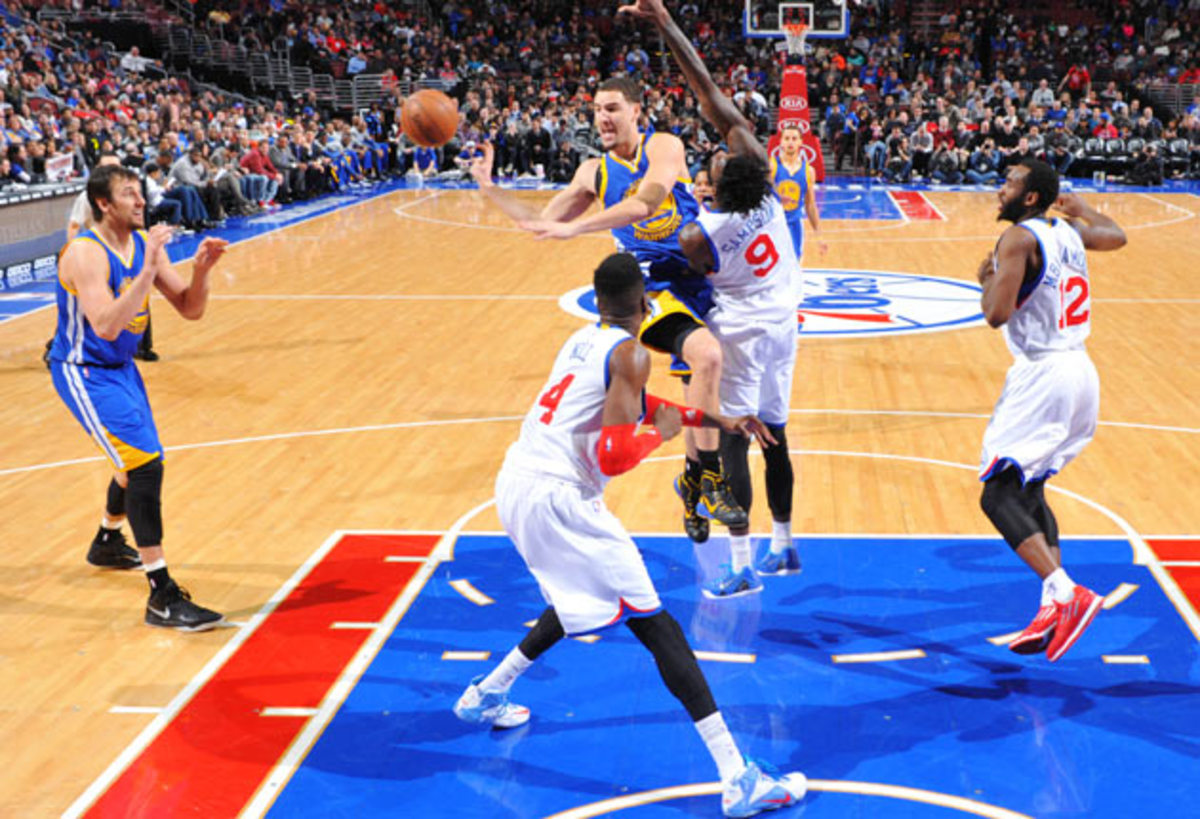
After debuting the offense in summer league, Kerr and Gentry installed it in training camp, while simultaneously focusing on conditioning. Initial results were mixed. There were moments of gorgeous passing and cutting, but there were also turnovers. Lots of turnovers. Seven games into the regular season, the Warriors were averaging 22 a game. For a coach like Kerr, who believes ball movement, limiting mistakes and defending are the keys to basketball, it was painful to watch. “I had so many ideas in my head,” Kerr admits now. “I put in too much.”
So he simplified the offense, from over 20 plays to a core of four or five sequences. It worked. The Warriors, one year after finishing last in the league in passes per game (245.8), are now 11th (313.6). They lead the NBA in both assists (1,389, tied with the Hawks) and hockey assists (8.1 per game), and they’ve cut their early-season turnover rate by a third (from 22.1 to 14.6). In previous years, Curry and Thompson often ended up launching difficult jumpers, and Thompson rarely ran off screens. This year, Thompson’s improvement is due in large part to the evolution of his game, but he and Curry are also getting easier shots. “No one ever knew how good Klay really was last year,” says one opposing coach. “Because Mark never ran any plays for him.” Which, in retrospect, may help explain why the Warriors opted not to trade Thompson for Kevin Love. Perhaps they knew something the rest of us didn’t after all.
There’s another trickle-down effect to the offense, however: as reserve guard Justin Holiday says, “everybody gets a taste.” Two role players in particular have benefited. The first is Barnes. As a cutter and kick-out threat, he’s now shooting over 50% from the field and making 43.2% of his threes.
Barnes’ improvement might have been predicted. The same can’t be said for another Warrior.
Many coaches would have given up on Mo Speights. The Warriors originally targeted the 6’10 reserve forward in free agency for one reason: he could hit midrange jumpers. But last year Speights showed up 30 pounds overweight and not even his jumper could keep him on the court. Even when in shape, Speights profiles as the opposite of Kerr & Co.’s preferred player: an unwilling passer and passive defender. “I wouldn’t have blamed Steve for ignoring him and counting the days until they could get rid of him,” says one Eastern Conference GM. “To me, incorporating Mo is the most impressive thing Steve’s done. How many coaches even try?”
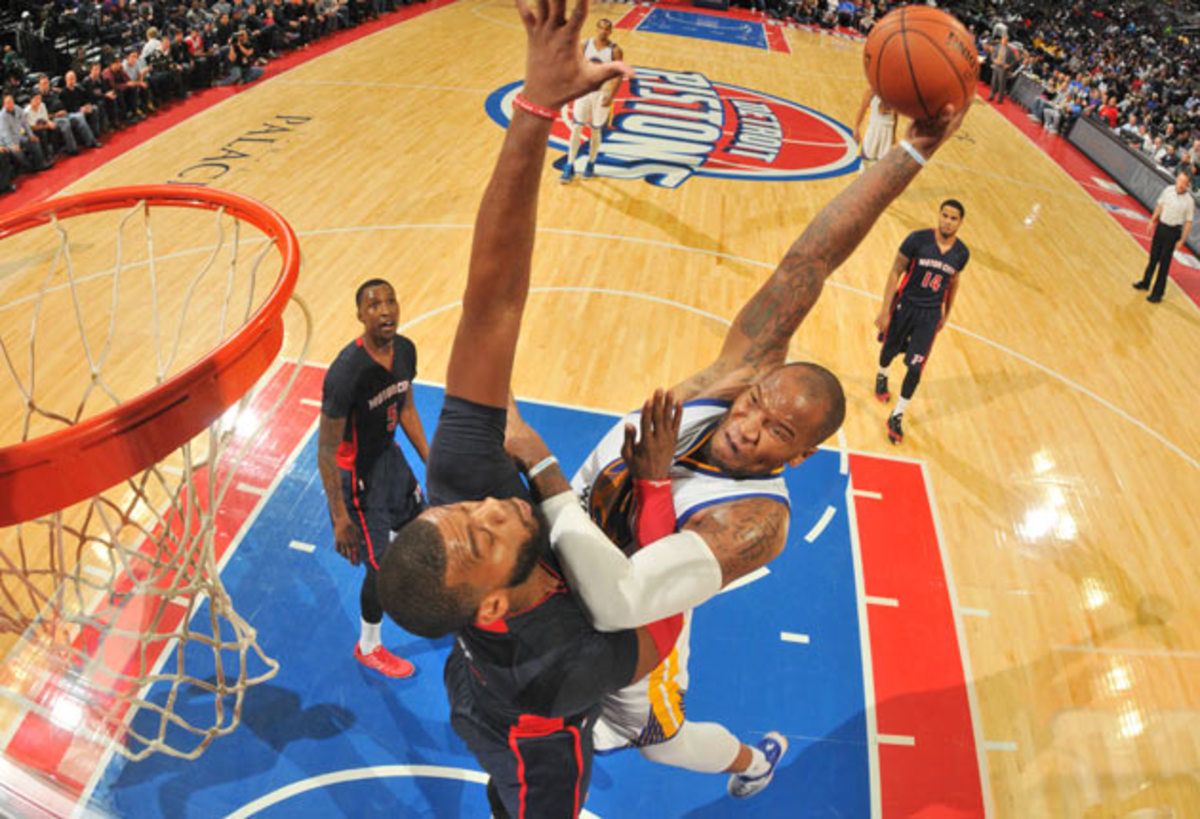
This season, Speights is averaging 12.0 ppg on 50.3% shooting while displaying surprising flashes of defensive intensity and voluntary passing. All of which, teammates believe, ties back to coaching. “No one ever ran plays for Mo before,” says Barnes. “Now there’s a play, it’s literally called ‘Mo’s Play,’ to get him an elbow jumper.”
Kerr, as is his nature, deflects credit. That’s all Mo, he says. I just told him if he came to camp in good shape that he’d have a chance to really help the team. It was assistant coach Luke Walton, a former teammate of Speights’ in Cleveland, who ran sprints with Mo every day after practice. And all this may be true, but it’s overlooking the advantage of a coach like Kerr: like Phil Jackson and Riley before him, he understands life on the margins. “I know what all those guys are going through, and it sucks,” says Kerr of the reserves. “I have great compassion for all the bench guys.”
Kerr strives to mimic Phil Jackson, who, “never let anybody rot at the end of the bench.” Says Kerr: “In ways the guys at the end of the bench define your chemistry. And if you ignore them, and they never play, they're going to get bitter. And all of a sudden it becomes insidious.”
So Kerr rewards good practice play with playing time, and gets mad at himself when he misses an opportunity to play bench guys (he says his biggest regret of the season was not getting Brandon Rush into an early season game when Thompson didn't play). “Steve is an extremely positive guy, but he's no one's fool,” says Adams. “He gives people opportunity. So the opportunity may come and it may go. There's no browbeating.”
So far, the players appreciate Kerr’s approach. Barnes credits his new coach for, “empowering the players,” while Green likes that he and Kerr can have a dialogue. “Earlier this season I yelled at him during the game and he yelled back,” says Green, who to be fair spends much of every game yelling at or with somebody. “Afterward I walked over to the sideline and said, ‘My bad.’ He said, ‘Nah, you’re fine. I love your passion, why would I try to stop that? That makes you the player who you are.”
Lacob describes Kerr as, “exactly who he sold himself as,” which, says Fraser, is one of Kerr’s best attributes. “There’s no bulls--tting about him,’ says Fraser. “He may be a bit nerdy, but you can’t say he’s not an honest, real guy. He does a good job of explaining and talking, not just commanding.”
As for Curry, he says he likes that Kerr didn’t, “try to come in and be the hero and reinvent the wheel when it came to what we were good at.” “He’s very mature for a first time head coach,” says Curry. “To be able to have an awareness of the bigger goals, not just having the best record right now.”
Green agrees: “He don’t let us settle for mediocrity in anything.”
One place that Kerr certaintly Kerr does not abide mediocrity: the stair stepper. After most every practice, Kerr engages in a one-man assault upon the hulking black machine in the corner of the Warriors’ practice facility, after which he does pushups and planks. Unless, as on a recent afternoon, he is challenged.
“Coach Kerr,” says Curry. “You want some today?”
As Curry says this, he is in the midst of hitting either 39 or 40 free throws in a row – it’s hard to keep track when the number gets that high. Hearing this, Fraser, who is Curry’s shooting coach most days, walks over and waves his arms at Kerr from afar, pointing at Kerr and then at Curry, mimicking free throws.
Kerr dismounts and prepares for battle. Though he was an 86.4% free throw shooter, he knows the odds are against him. He and Curry typically play a game to 10, shooting two free throws at a time, where each make is worth one point but a swish is worth two. And, as you might imagine, Steph does a lot of swishing. At one point, says Kerr, the two had battled 11 times, during which time he had made roughly 84 out of 85 free throws—and won only once. “Steph swishes them all.”
On the surface, the competition seems a fun diversion. But, like most things with Kerr, it’s more than that. What is coaching if not a power balancing act? Here is Kerr, one of the best shooters in NBA history and a famously (if quietly) competitive man, willing to publicly lose, repeatedly, to his star player. That takes a certain innate confidence that carries over to other areas. At the end of timeouts, he often asks the team if they’re seeing anything he isn’t. Earlier this year, reserve Leandro Barbosa suggested a late-game play. Kerr not only listened; he used it.
The shooting contest also aligns with a core Kerr concept, which he talks about with Fraser often: maintaining the joy of the game. It’s why he once held impromptu 2-on-2 football route-running competitions instead of traditional warm-ups before practice. It’s why he took the team bowling, as he did two weeks ago in Minneapolis, overseeing a 2-on-2 competition in which all players were seeded based on perceived ability (in a complete shocker, Curry’s team won).
Kerr is also a believer in process and preparation. He asks the video staff to load the previous five games of an upcoming opponent on his laptop leading up to a game. Last July he visited Pete Carroll and was impressed with how Carroll used music to energize the Seahawks in practice. Now the Warriors do the same thing. Following an example set by both Carroll and Bill Belichick, Kerr hired as his personal assistant Nick U’Ren, a 28-year-old who’d spent the previous five years as an assistant video coordinator with the Suns. Explains U’Ren: “The idea is that rather than have a 45-year-old woman behind a desk answering mail as your assistant, why not instead use that spot to add another young basketball mind to the staff.” So now U’Ren does both; on any given day he might book Kerr’s travel, splice video footage and spend 20 minutes breaking down game strategy with his boss. As far as he knows, he’s the only person in the NBA with his job.
Other times, Kerr’s moves are diplomatic. From day one, he has made a point of consistently praising Mark Jackson, which built good will with his players. Similarly, he downplays his impact on the team at every turn. “In the end both Pop and Phil taught me the players are the ones that do all the work,” says Kerr. “You just want to guide the team in the right direction to play the way that they're best going to utilize their talent and skills.” In pro sports, this mindset is unusual. “Usually winning breeds arrogance but he’s a rare guy,” says Van Gundy, who makes a point to also praise Mark Jackson’s work as Warriors coach. “I think Kerr’s fully aware that he’s done an outstanding job. You don’t play as long as he did without great pride and ego. But the way that Steve has handled himself, forget the coaching. What I have such great respect for is his humility with this success. Very, very few people I’ve known in coaching would have this humility with this success.”
That Kerr is also comfortable with the media doesn’t come as a surprise. As a former broadcaster (and one-time sports columnist for his high school paper), he understands the power of narrative. Take the famous story of how he and Michael Jordan got into a fight after practice, oft-cited as proof of Kerr’s fire and toughness. “Let’s be honest,” says Kerr. “If we were losing right now, the narrative would be, ‘This is a guy that got beat up by Michael Jordan.’ We just tailor the facts to however the story is going.”
If that’s true, the facts aren’t cooperating on this day. After a few warm-ups, Kerr bricks his first two free throws. Then Curry bricks one of his first two. “Oh no, I tried to go for the swish!” he yells.
Presently, both begin making their shots and, as usual, Curry goes on to win on yet another moonball swish, after which he runs off in celebration before returning to pantomime a golfer’s handshake. But, for a moment, it was interesting to see the two of them there, disgusted with themselves and trying not to show it.
Two men bent on winning, united by a momentary failure.
